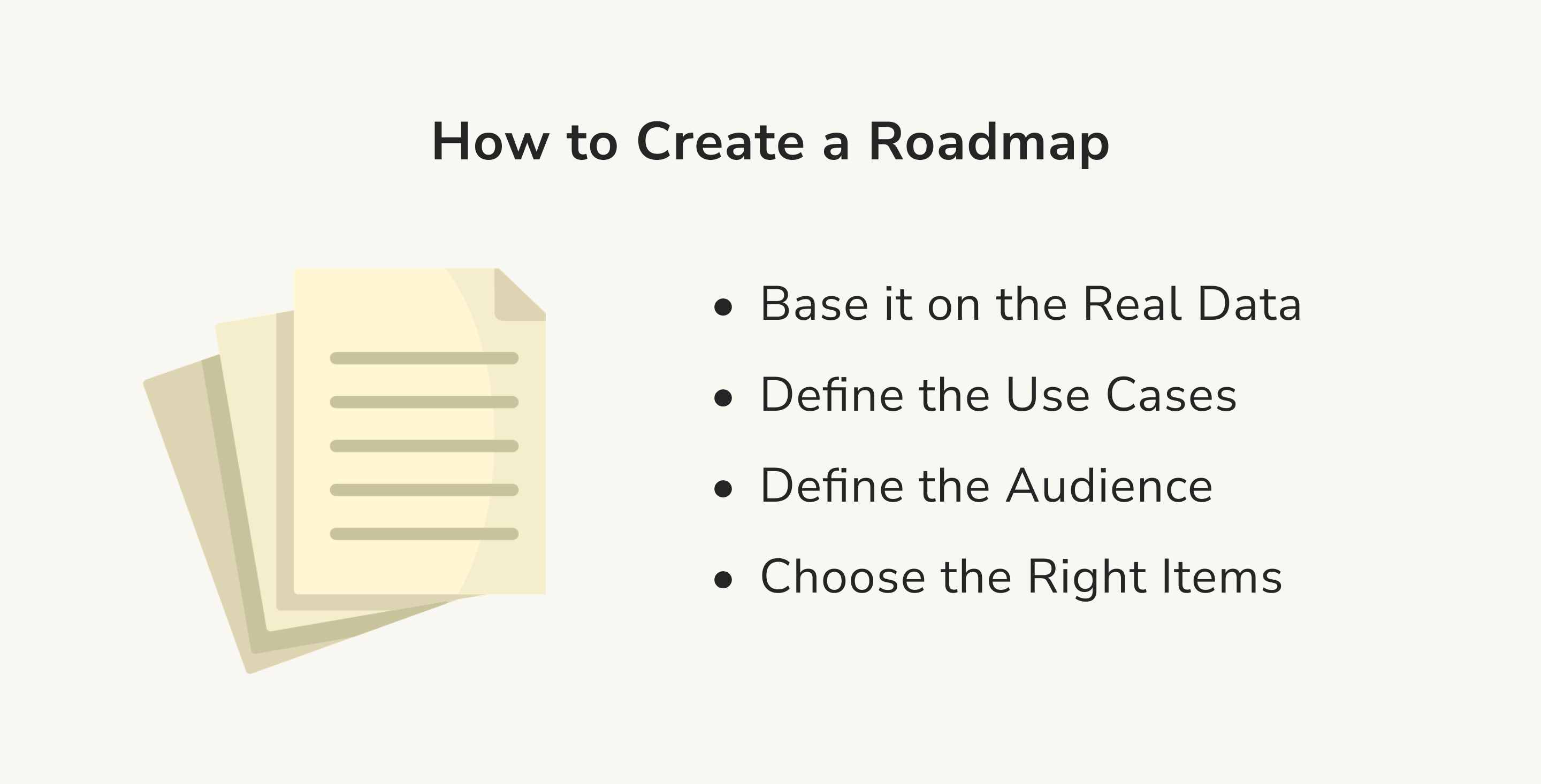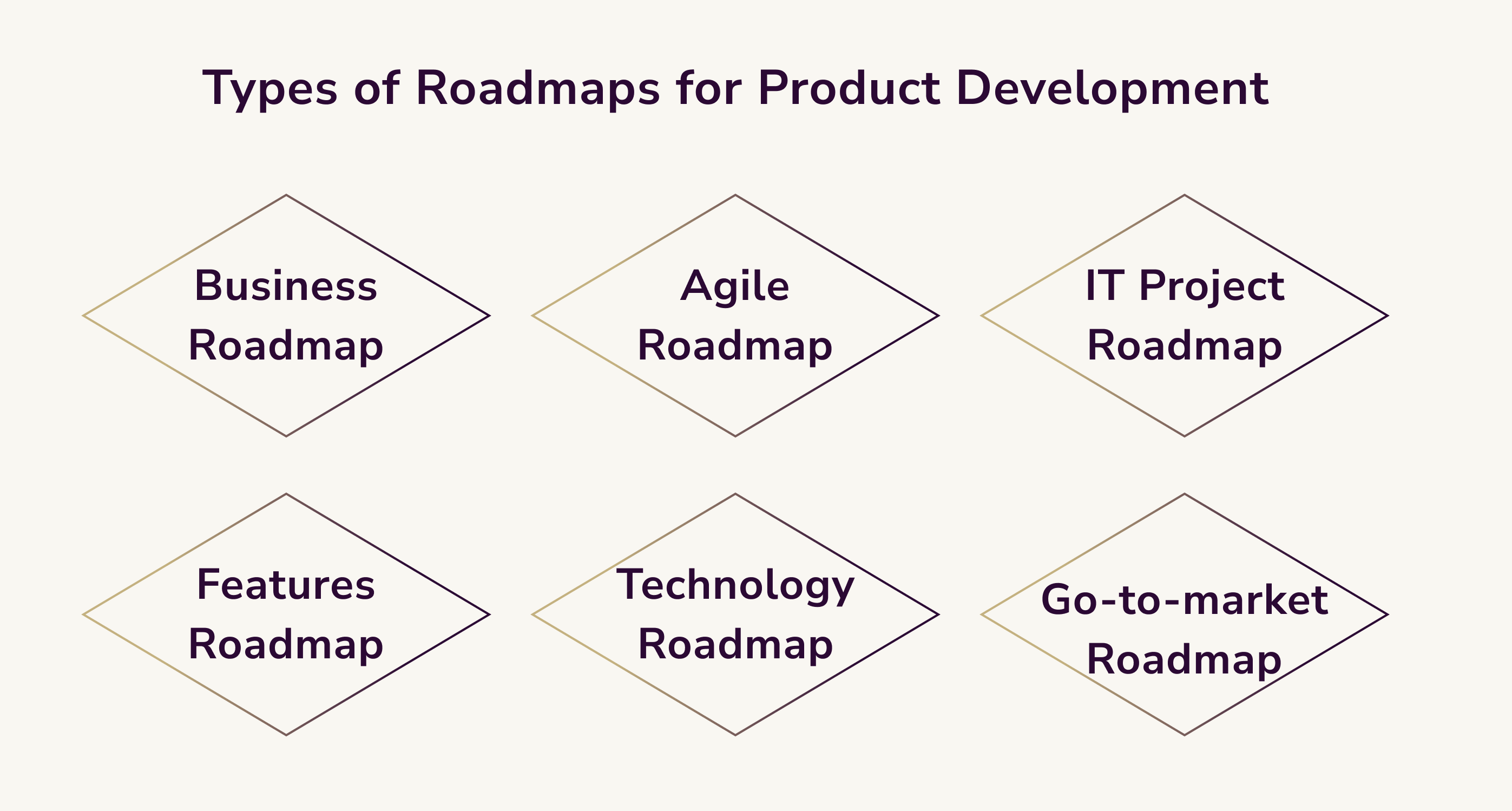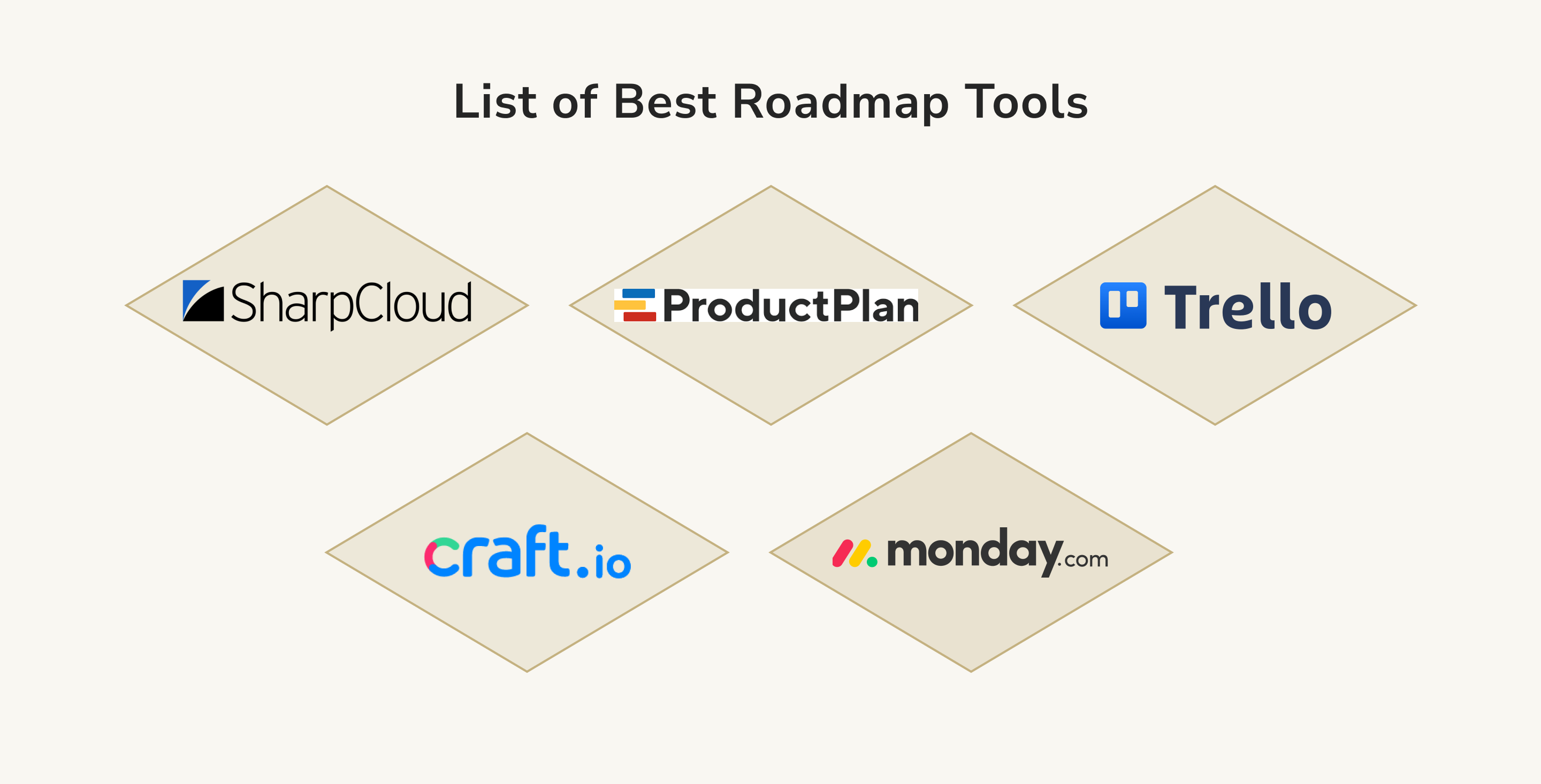How to Create Roadmap in Product Development: A Brief Guide

You’re done with the bold idea for your business. Strategic planning and the groundwork are finished, and you’re thrilled to start a product development journey. Now, it is time to build a product development roadmap to visualize the direction toward the launch.
A roadmap displays your product vision and is a way to put your plans into action. It is a useful tool for communicating your priorities to teams and stakeholders and tracking the advance against your milestones.
Developing a software development roadmap helps you link your business goals to team milestones, set the right priorities and timelines, predict how many resources you will need, etc.
So, if you’re a large enterprise, corporate business, early-stage startup, or just a person with an idea, a roadmap will be essential for a custom software product development company that has to turn your plans into reality. And this article will give you a general idea of how to make a roadmap.
Benefits of Creating the Software Product Development Roadmap
A product development roadmap helps the founders to see the future of their solutions and the greater “what, why, and how” behind the work of software development partners. As follows, the roadmap for product development has many advantages that can benefit both industry heavyweights and small startups.
Being Competitive
It’s not a secret that a market is a cruel place where businesses fight to be the most competitive. Competing at the fairest price is no longer an advantage in the 21st century and doesn’t work in the digital product market.
Instead, entrepreneurs and startup founders attract users with easy-to-use interfaces, exclusive features, and the latest technologies to facilitate the customer journey. The software development roadmap helps define the time and amount of effort to implement the most distinct perks for the users and stay on top of the market.
Spotify is a company with a great product roadmap example. It revolutionized how people listen to music by allowing fans to access any tracks for free or pay for a better listening experience without ads. Spotify was among the first companies that decided to fight piracy and provide people with good music for free at the same time. Listeners liked both ideas: avoiding piracy and listening to favorite tracks for free. Now, Spotify has more than 406 million monthly active subscribers.
Linking Business Goals with Department Milestones
Software product roadmap helps to align IT milestones and business objectives. It facilitates interdepartmental communication and shows the straightforward way to develop your product.
Spoiler: software developers are not money wasters. If you think you’re spending too much, you either lack a product roadmap or need a more detailed one. IT departments cannot fulfill your request if it is not properly explained or documented. In other words, you still need a good roadmap for product development.
Predicting IT Budget
One of the greatest benefits of any roadmap is the ability to predict and plan expenses. A product roadmap defines the approximate timeframes for developing new features, implementing processes, and using additional tools. Thus, it also establishes a plan for your upcoming spending.
Although some unplanned expenses can happen, like hardware failure, the budget plan in the product development roadmap helps to make predictable investments into the software part of your solution.
Planning Hires: Ability to Attract Better IT Talents
We bet you’ve had a situation when you needed a professional, but the market was burning, and you couldn’t find the right fit for your position. An organized roadmap for product development helps avoid “fires with hires” as it defines the requirements and, therefore, helps predict the needs of new professionals in a team.
Besides, knowing about the need for new talent in advance ensures that you get a better fit for the job. There are several reasons for it. Firstly, talent acquisition professionals can start searching for candidates long before they are actually needed. Secondly, you will have more time for interviews and conduct them without a hurry. You will have time to check more candidates and find the one that fits all your job requirements.
Freeing Up Employees' Hands for Important Tasks
A software development roadmap helps you to use employee time more effectively. As follows, the roadmap emphasizes the short- and long-term business goals and draws team members’ attention to them. Employees see the priorities and work directly towards fulfilling them in the most efficient way.
Moreover, the product roadmap’s key priority is to delineate the routine tasks that can be automated and free up the team’s hands for the more complicated work. Due to this, employees see crucial challenges in product development from the very beginning and do not let these issues become a pain in the neck.
How to Build a Product Roadmap

Base it on the Real Data
Gladly, we live in a world where all data is accessible on the Internet or stored on computers. There is no place for guessing when building a product development roadmap.
The examples of data IT directors can use for improving the roadmap include historical data on gross and net incomes, resource usage data, financial estimates for the next quarters or years, and current infrastructure speed and performance.
Of course, this list can never be complete, and different specialists can add different types of data to it. Yet, the purpose of using data when creating a project roadmap is clear, right? The more relevant data you have, the more precise the roadmap is.
Define the Use Cases
Have you ever thought of building a house without a plan, e.g., the roadmap? No worries. It was a rhetorical question — no one builds a home without the project and the use cases. The same goes for digital products.
So, it would be best if you visualized what you want to build. In other words, you need to create use cases. They will have numerous implications on the structure of the software development roadmap and what information it should contain.
Ask yourself: are you creating a product roadmap for product development for a specific product launch, or should it show how your project portfolio scales over time?
In the first case, you’ll need to focus on a short timeframe, work only on one particular product, and have strict and specific deadlines for milestone deliverables and launches. While in the second example, your roadmap will have a long time horizon, deal with several products, and define no strict deadlines. Specific deadlines, in this case, will lead to fake precision.
Define the Audience
As every product has its target audience, every software development roadmap focuses on a specific group of people who will use it.
So, if you’re creating a roadmap for C-levels, they will mainly be interested in the rough timeline and no technical specifications. The same applies to the content marketing team. They need project deadlines indicated to create scheduling for content marketing campaigns.
The situation is quite different when you develop a product roadmap only for customers. In this roadmap, you should not indicate exact time estimates to avoid giving promises of what you cannot deliver.
Finally, if you build a roadmap for the product or development team, you can avoid timing and focus more on milestones and technical requirements. Usually, the software development team needs more details than C-levels, as they are the people who will build your product.
Choose the Right Items
Rule of thumb here: do not bite more than you can chew. Once you set critical points, start prioritizing the requirements and features. The roadmap for software development without prioritization is not structured and organized. Thus, it will not help you in product development.
Types of Roadmaps for Product Development

Business Roadmap
A business roadmap for product development sets the direction your company has to follow to reach your business goals. It ties initiatives to business targets and success metrics. This type of roadmap helps communicate the visions and objectives at the growth stages. It can be applied both by large enterprises and early-stage startups.
The purpose of the business roadmap is to picture the way and specific steps that are needed to transform your idea into reality. Usually, business roadmaps are adjustable: they can be either detailed or abstract, depending on the maturity phase of your vision or business.
Agile Roadmap
If you need a lightweight strategic tool for product development, then an agile roadmap is what you’re looking for. As follows, it sets general timelines for major themes of work. These themes can be directly related to features, product goals, or epics.
In other words, an agile product development roadmap is a transparent high-level strategy built around business value.
The next question is: when to use an agile product development roadmap? They are the most helpful when you start working on something new. It can be a new feature set, an entirely new solution, or the release of an updated version of the product. In this case, the agile roadmap answers "the why, the what, and the how" of what you strive to build.
Finally, the word “agile” is all about flexibility. Thus, the product plan has to be easy to update and manage. So, static spreadsheets are not the best option to create an agile product development roadmap.
IT Project Roadmap
IT project roadmap is a mix of all roadmaps. It unites strategy, objectives, resources, milestones, and features in one timeframe.
As follows, an IT project roadmap helps to see the bigger picture. It connects releases to larger IT and business goals such as process automation, internal mobilization, gathering additional data, and planning infrastructure.
Features Roadmap
The name of the features roadmap explains everything about it. It unites all work in flight for a particular timeline. As follows, the features product roadmap can contain vertical columns and swimlanes for different milestones.
Small tip: when creating the features roadmap, place each release in columns corresponding to the deadline (e.g., a quarter in the year). It will be easy for different people to use this roadmap and see when the new deliverables are soon to come.
Technology Roadmap
A technology roadmap is a visualization of how software development supports your business goals. Before you go with “how” and start the actual development of your solution, the technology roadmaps answer all other questions, notably:
- What are you building?
- Why are you building this particular solution?
- When to expect the roll-out of the product and new integrations?
Technology roadmaps are usually created to address complex tasks like infrastructure updates or data transformation management. Operations or engineering professionals frequently develop a technology roadmap for software development for other internal teams or external partners.
(Also, check our article on other technical documentation).
Go-to-market Roadmap
If your task is to structure everything that must be done before launch, then you need a go-to-market roadmap. It contains cross-functional activities and priorities for all teams. For example, you can include drafting a creative brief and developing a customer portal UI in one roadmap.
Go-to-market roadmap works as a tracker that helps make sure that all work is delivered on time and product launch is secured.
Tools to Create a Roadmap in Software Development
Things to Consider
Before building a roadmap for product development and choosing the tool for road mapping, there’re a few things to consider.
What does the roadmap show?
Roadmap product development serves different purposes. They can help you launch a new version of the application, implement a few features, or lead the product development from the idea phase to the launch.
Some roadmaps are straightforward plans to get to the treasure in the end, while others can be extremely tech-oriented with a detailed view of every aspect of the product.
This is why it’s crucial to decide on the roadmap type before using any road-mapping tool. Developing a roadmap in a statical spreadsheet is not good if you need a dynamic and detailed product development plan.
Who will manage and update your product roadmap?
Any roadmap for product development is always managed and updated by the product team.
In larger companies, the roadmaps can be maintained by several people from the product squad or the engineering, operations, and customer success departments. In smaller teams, the maintenance of software product roadmaps is easier as they are built and updated by only one product manager.
So, suppose you have a small team and only one person who will maintain the product roadmap. In that case, you should choose the tool without sophisticated collaboration features and save money for something else.
Yet, if several people should own and update your plan, you need to opt for a collaborative tool for creating product development roadmaps.
Who will have access to the roadmap?
It’s not a secret that the purpose of a roadmap for software development is to gaze into the future and facilitate internal processes of how the product is planned and built. Although the roadmap brings the most value to the product management team, it can also help other teams.
For instance, the content marketing department can plan its promotion campaigns based on the release of new features. The management team can check the statutes of work done and tell the customer when to expect the release of a new version with extended functionality.
However, the most important team that may need to take a look at your software product development roadmap is your customers. You encourage trust when you show your plan to your prospects.
However, not every road-mapping tool has a customer view option. So, if you want to be transparent with your customer and enhance the trust level, make sure you decide on a tool that enables customer view.
List of Best Roadmap Tools
ProductPlan
ProductPlan is a collaborative tool for road mapping. It allows you to share as many product roadmaps as you want to keep everybody in the loop. Besides, ProductPlan has an easy drag-and-drop interface so that even an 8-year-old can build a test roadmap there.
As with every road-mapping tool, ProductPlan has its pros and cons. The advantages of this tool are:
- an intuitive design that simplifies using
- ability to add and remove timelines, connect related items
- color-code items which define different stages of the product development
- easy integration into different project management systems
However, users still highlight some drawbacks, such as expensiveness and the inability to upload an Excel spreadsheet to map up the initial scheme.
Monday.com
Being a universal road-mapping solution, Monday.com can be used by both small and large teams. Some view it as the best tool for product roadmap.
The huge plus of Monday.com is 24/7 support team availability. So, besides the ability to plan, track, and manage project progress, you’re also exposed to a friendly team of support engineers. On Monday.com, you also can find recorded webinars and tutorials to understand better how to create a product roadmap. The users also frequently mention a simple user interface as a considerable advantage.
Still, many crucial features are not included in the basic subscription, and pricing plans can sometimes be confusing for the users. Finally, the interface related to task tracking is not intuitive and is hard to use.
SharpCloud
SharpCloud is a great tool for product roadmap that offers not only the ability to create the project plan but also road-mapping guidance in the form of webinars and eBooks.
The tool shows the path toward meeting your goals. Moreover, it helps you create a roadmap product development in a few minutes if you have all the data in a spreadsheet. In addition, it displays the whole decision-making process, so it is convenient for the team to use it.
Among the disadvantages of SharpCloud, users note too many unnecessary features that make the software complicated and, thus, the tool requires much time to get used to.

Craft.io
Road-mapping, feedback capturing, workflow planning, and customization are all the futures of one software called Craft.io. It is a comprehensive solution for product teams that helps to define specs, set and share crucial decisions, and regulate workflow.
What’s more, Craft.io easily integrates with Azure DevOps, Jira, Dropbox, Google Drive, Github, and plenty of other software. This road-mapping tool tracks all product-related information and team feedback with all these integrations.
Despite many benefits, Craft.io can be hard to use by the whole team. Also, it is overwhelming for small-scale projects that need a bit limited range of features. So, Craft.io is something like a golden mean for product management teams.
Trello
Although Trello is known as a tool for managing projects, it can also be used to map out product plans due to its customizability. However, the software allows the creation of only rudimentary product roadmaps with “Now,” “Next,” and “Future” columns. So, in the end, you will get a simple Kanban roadmap.
Nonetheless, Trello has a huge strength compared to other road-mapping tools. It has a collaborative functionality, and you can easily share your software product development roadmap with stakeholders and team members. Besides, Trello has a few useful integrations, notably Google Sheets, Github, and Airfocus.
Yet, Trello isn’t a tool designed specifically for creating a product roadmap. It lacks important functionality, such as task prioritization and different sharing options.
Myths about Roadmaps
Now you know how to write a product roadmap, the only thing left is to clarify a few things and break a few misconceptions.
“A Product Roadmap Is a Backlog”
Some teams mistake a product development roadmap with a backlog. However, a backlog is a list of upcoming tasks, while a roadmap is used to prioritize tasks and decide what to do next.
Not to confuse yourself, think of a roadmap as a high-level strategy created out of backlog points.
“Roadmaps Serve as a Tracker for Project Management”
Many managers think that a product roadmap in Jira is a project management tracker.
However, they forget that a product roadmap is a high-level plan that is incomplete with all the details. It misses the individual tasks, the list of team members and their responsibilities on a project, detailed deadlines for completing each milestone, meetings scheduled to discuss specific issues or progress, and many more. For such things, management teams have to use specific tools like JIRA or PivotalTracker.
“A Product Roadmap Should Define Exact Deadlines”
Software development roadmaps visualize what should be done, and, of course, they contain deadlines. Yet, it doesn’t mean that exact dates should be included. Plans can be made on broader timelines, such as quarters, months, and years.
Remember that a product roadmap is not detailed milestone planning. It’s a scheme of checkpoints to ensure that the project is in progress.
“Roadmaps Cannot Be Adjusted”
Without a doubt, a roadmap for software development is a commitment, and it defines what you will do in the next quarter or year. Still, it is important to realize that you create the initial plan first, and your priorities may shift over time. Therefore, if priorities change, dates have to be adjusted as well.
“A Product Roadmap Slows Up the Agile Team”
Agile teams are effective because they are continuously iterating and delivering. Some agile project managers think that a product development roadmap with dates will slow down the pace of their team.
However, it is one more myth about software roadmaps. They make Agile or any other team even more efficient by providing clear direction to launch and setting transparent priorities.
Conclusion
Wrapping up, a roadmap product development is a direction to the treasure — your product. Roadmaps help businesses to become competitive, link their business objectives to department tasks, predict expenses and plan a budget, attract better talent, and free up team hands to concentrate on crucial tasks. But, most importantly, they assist you in going through product development with minimum losses.
So, if you’re still pondering whether a product development roadmap is what you need, look at Uber or Spotify, which created their roadmaps back in their early days, followed the product roadmap strategy, and made the right decision!
Turn to the Impressit team for the discovery and planning phase, so we are able to help you kick-start the development.

Roman Zomko
Other articles